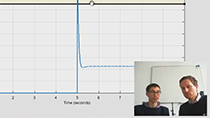Mathematical Models | Improving Your Racecar Development, Part 1
From the series: Improving Your Racecar Development
Model the physical systems of your racecar and learn about the variety of modeling methods that fit your needs. This is the first video of a two-part episode. Sebastian Castro and Christoph Hahn, of MathWorks, introduce a variety of modeling approaches and demonstrate them in Simulink®.
Sebastian describes the differences between plant models and algorithmic models and how to decide which model is best for your situation. Plant models are a virtual prototype of a real physical system that you are trying to model, whereas an algorithmic model is where you can test your algorithms on your simulation. With Simulink you can combine these two types of modeling and use available analysis tools to then further improve your design.
The many varieties of modeling include those using purely data or purely mathematical equations, and then combinations using both of these methods. Sebastian starts by looking at a suspension system using the mathematical modeling method to see how easy-to-understand equations can be used to create a model. With that same suspension system, he then moves the focus away from equations and demonstrates component-based modeling using Simscape™. This is a tool for component-based modeling that uses blocks which have the equations in the background. The benefit of this method is that you do not need to know as much detail about the equations.
Find all models used in this episode on MATLAB Central File Exchange.
Published: 20 May 2015






